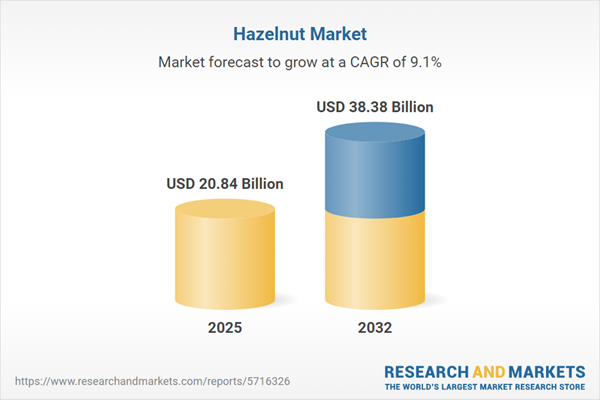Speak directly to the analyst to clarify any post sales queries you may have.
The global hazelnut market is undergoing notable transformation as sustainability, supply chain transparency, and evolving consumer priorities prompt senior leaders to recalibrate sourcing and innovation strategies. Staying ahead requires updated market intelligence grounded in real-world trends, competitive shifts, and regulatory developments.
Market Snapshot: Hazelnut Market Growth and Trends
The hazelnut market is set to expand from USD 19.05 billion in 2024 to USD 20.84 billion in 2025, with a strong trajectory leading to USD 38.38 billion by 2032, reflecting a CAGR of 9.14%. This sustained growth is fueled by increased integration of hazelnuts into premium food categories and rising consumer appetite for functional ingredients. Manufacturers are moving towards innovative product development, prioritizing plant-based formulations, clean-label credentials, and enhanced traceability across the value chain. Advances in processing are enabling improved efficiency and consistency, with sustainability and product quality central to competitive positioning. Regional demand patterns and adoption of differentiated product formats also support continued robust performance in key global markets.
Scope & Segmentation: Hazelnut Sector Breakdown
- Product Types: Kernel formats include blanched, raw, roasted, and processed options such as hazelnut oil, paste, and whole nuts. These address both ingredient formulation needs and final consumer goods, supporting tailored applications for manufacturers, food processors, and retail brands.
- Applications: Hazelnuts are used in bakery products, confectionery (including chocolate, bars, and pralines), dairy alternatives, and sweet and savory snacks. Their unique profile facilitates adaptation across innovation pipelines, from traditional goods to emerging categories.
- Distribution Channels: The market is served through supermarkets, hypermarkets, convenience stores, specialty retailers, and online platforms. This mix ensures resilience against fluctuating consumer purchasing habits and supports deeper market penetration through omni-channel strategies.
- Packaging Types: Industrial buyers prefer bulk packaging for efficiency and scale, while consumer-facing packages focus on shelf appeal, sustainability, and brand distinction. Packaging choices influence both operational cost management and end-user perceptions.
- Regional Focus: The Americas, EMEA, and Asia-Pacific regions each shape distinctive growth opportunities. Regional nuances such as regulatory emphasis, taste preferences, and market maturity drive tailored go-to-market approaches and local partnerships.
- Key Market Players: Major companies include Ferrero International S.A., Olam International Limited, Balsu Gıda Sanayi ve Ticaret A.Ş., Barry Callebaut AG, Nestlé S.A., Gerbs LLC, Intersnack Group GmbH & Co. KG, Kerry Group plc, American Hazelnut Company LLC, and B&G Foods Inc. Their ongoing investments fuel advances in R&D, supply capabilities, and global reach.
Key Takeaways for Decision-Makers
- Sustainable sourcing and regenerative agriculture initiatives are becoming core components of strategic supply management, supporting brand reputation and stakeholder trust.
- Investment in advanced processing and digital traceability systems boosts compliance, mitigates risk, and helps position premium hazelnut products within global supply networks.
- Direct-to-consumer models and expanded digital engagement enable producers to enhance responsiveness, control branding, and adapt quickly to changing customer requirements.
- Distinct demand drivers—such as rising preference for plant-based snacks in Asia-Pacific and emphasis on certifications in Europe—necessitate regionally adapted channel and product strategies.
- Close collaboration on R&D and offering tailored ingredient solutions enable rapid new product development, particularly valuable in bakery, dairy alternatives, and snack segments meeting emerging consumer expectations.
Tariff Impact and Trade Responses
Recent tariff shifts in the United States are creating volatility in sourcing costs and impacting pricing decisions for both importers and domestic suppliers. To address these changes, industry players are turning to greater investment in domestic production, forging stronger partnerships with regional stakeholders, and renegotiating supplier agreements. Long-term contracts and diversified trade relationships are in greater focus for downstream buyers, notably in confectionery and bakery segments, while distribution systems are evolving to address regulatory uncertainty and preserve supply chain integrity.
Methodology & Data Sources
This report leverages a mixed-methods research framework, combining primary interviews with hazelnut growers, processors, and distributors with secondary review of current industry publications and regulations. Validation is achieved through expert roundtables and direct observation, ensuring a balanced, actionable analysis for strategic decisions.
Why This Hazelnut Market Report Matters
- Delivers actionable supply chain and investment insights by segmenting the market and presenting recent data to foster confident decision-making.
- Offers executives forward-looking market intelligence on regulatory changes, tariff developments, and technology advancements directly affecting supply and value chain strategies.
- Highlights emerging opportunities in response to regional consumption shifts, showcasing pathways for successful product and portfolio innovation.
Conclusion
Current analysis of the hazelnut market ensures senior leaders have the knowledge required to navigate evolving consumer dynamics, regulatory fluctuations, and technology enhancements. Strategic insight empowers organizations to capture growth both regionally and globally.
Additional Product Information:
- Purchase of this report includes 1 year online access with quarterly updates.
- This report can be updated on request. Please contact our Customer Experience team using the Ask a Question widget on our website.
Table of Contents
3. Executive Summary
4. Market Overview
7. Cumulative Impact of Artificial Intelligence 2025
List of Figures
Companies Mentioned
The key companies profiled in this Hazelnut market report include:- Ferrero International S.A.
- Olam International Limited
- Balsu Gıda Sanayi ve Ticaret A.Ş.
- Barry Callebaut AG
- Nestlé S.A.
- Gerbs, LLC
- Intersnack Group GmbH & Co. KG
- Kerry Group plc
- American Hazelnut Company, LLC
- B&G Foods, Inc.
Table Information
| Report Attribute | Details |
|---|---|
| No. of Pages | 192 |
| Published | October 2025 |
| Forecast Period | 2025 - 2032 |
| Estimated Market Value ( USD | $ 20.84 Billion |
| Forecasted Market Value ( USD | $ 38.38 Billion |
| Compound Annual Growth Rate | 9.1% |
| Regions Covered | Global |
| No. of Companies Mentioned | 11 |









